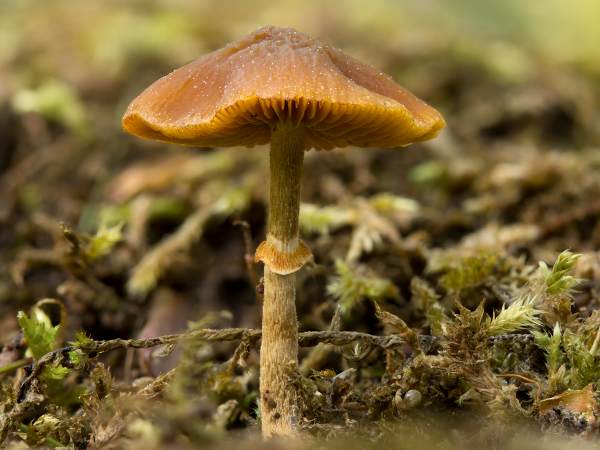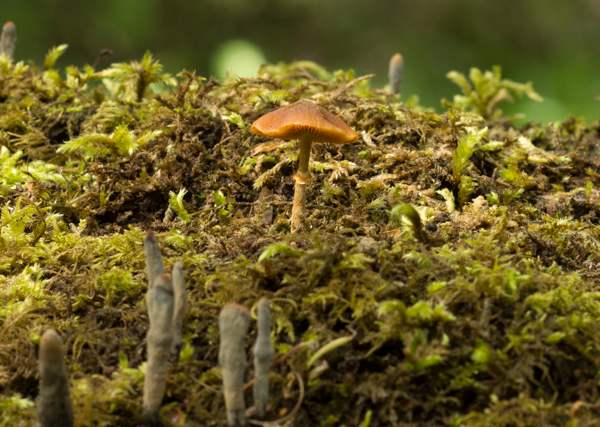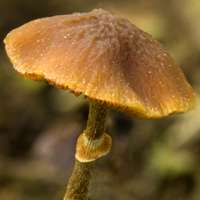Trees Birds Mammals Fish Amphibians Reptiles
Wild Algarve
Bookshop
Conocybe rugosa (Peck) Watling - Wrinkled Conecap
Phylum: Basidiomycota - Class: Agaricomycetes - Order: Agaricales - Family: Bolbitiaceae
Distribution - Taxonomic History - Etymology - Identification - Culinary Notes - Reference Sources

Conecaps are neat little mushrooms, but some species in this group are poisonous. For this reason small children should not be allowed to play with or near to Conocybe species.
Distribution
Conocybe rugosa is uncommon to rare in Britain and Ireland; it occurs also in many other countries on mainland Europe. This grassland mushroom is also found in parts of North America.

Taxonomic history
This lovely conecap was first described scientifically in 1898 by American mycologist Charles Horton Peck (1833 - 1917), who named it Pholiota rugosa. This species was transferred to its present genus in 1981 by the British mycologist Roy Watling (b. 1938), at which point its binomial name became Conocybe rugosa.
Synonyms of Conocybe rugosa include Pholiota rugosa Peck and Pholiotina rugosa (Peck) Singer.
Etymology
The generic name Conocybe comes from the Latin Conus meaning a cone, and cybe meaning a head - hence 'with a conical head', or in other words conecap. Less obviously, the specific epithet rugosa means wrinkled - a reference to the texture of the cap surface.
Identification guide
 |
Cap
1 to 2.5cm in diameter, the caps
are conical at first, becoming bell-shaped or broadly convex with faint marginal striations. The surface is smooth or slighyly wrinkled, dry and
tawny-brown to butterscotch brown with a paler margin; hygrophanous, becoming buffish in prolonged dry weather. |
 |
Gills
This attractive conecap has adnexed thin gills that are moderately crowded. Initially pale buff, the
gills turn light brown and then rust coloured as the spores mature; the gill edges are paler than the gill faces.
|
 |
Stem
Slender straightish stems of Conocybe rugosa are level, 1 to 3mm in diameter and 1.5 to 5cm long, becoming hollow and
fragile; buff background with rusty brown longitudinal striations; finely granular and paler above a radially striate buff ring that becomes stained with rust-brown spores.
|
 |
Spores
Ellipsoidal, smooth, 8.8-9.8 x 5.2-5.6μm; with a germ pore approx. 1.2μm wide.
Spore print
Yellow-brown.
Basidia
Four-spored. |
 |
Cheilostidia (gill-edge cystidia)
The cheilolocystidia are lageniform (flask shaped), typically 42 x 12μm with narrow apical necks 2.5-3μm across.
|
Odour/taste |
Not distinctive. |
Habitat & Ecological role |
Saprobic, appearing on leaf litter, peaty garden compost and mossy woodland floors. |
Season |
July to October in Britain and Ireland. |
Similar species |
Conocybe tenera, the Common Conecap, is a more sharply conical mushroom that appears briefly on lawns other grassy areas; it does not have a stem ring. |
Culinary Notes
It is unclear whether this conecap is edible; it might even be poisonous. With its small size and thin flesh, this uncommon mushroom is of no culinary interest.
Reference Sources
Fascinated by Fungi, 2nd Edition, Pat O'Reilly 2016, reprinted by Coch-y-bonddu Books in 2022.
Watling, R. (1982). British Fungus Flora: Agarics and Boleti. Vol 3. Bolbitiaceae: Agrocybe, Bolbitius, & Conocybe. Royal Botanic Garden, Edinburgh, Scotland.
Dictionary of the Fungi; Paul M. Kirk, Paul F. Cannon, David W. Minter and J. A. Stalpers; CABI, 2008
Taxonomic history and synonym information on these pages is drawn from many sources but in particular from the British Mycological Society's GB Checklist of Fungi.
Acknowledgements
This page includes photographs kindly contributed by David Kelly.
Top of page...
Fascinated by Fungi. Back by popular demand, Pat O'Reilly's best-selling 450-page hardback book is available now. The latest second edition was republished with a sparkling new cover design in September 2022 by Coch-y-Bonddu Books. Full details and copies are available from the publisher's online bookshop...